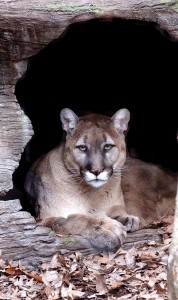Eastern cougar declared officially extinct
The U.S. Fish and Wildlife Service announced Wednesday that the agency’s wildlife biologists have concluded the eastern mountain lion is extinct. But local believers said the declaration is contradicted by dozens of reported local sightings.
According to Meagan Racey of the Fish and Wildlife Service’s Northeast Regional Office in Hadley, the declaration comes after the release of the results of a five-year review of the eastern mountain lion conducted by the region’s wildlife biologists. Racey said the report showed that there are no longer wild populations of the mountain lion subspecies.
Mark McCollough (the main biologist who conducted the review) said it was with some sadness that he drew his conclusions about the cats. “It’s not easy for an endangered species biologist to admit that we’ve lost a species, but we have to conclude where science takes us” – he said Wednesday by phone from the Fish and Wildlife Field Office in Orono, Maine.
The U.S. Fish and Wildlife Service today declared the eastern cougar, a subspecies of the puma or mountain lion, extinct following a status review that could not authenticate any records of the animal since the last confirmed individual was killed in 1938 in Maine. Only one other subspecies of puma from the eastern United States (the Florida panther) survives. Florida panthers once ranged throughout the Southeast, but are now besieged by sprawl in a single, remnant population in South Florida.
“Official confirmation of the eastern cougar’s extinction is a belated warning that our ecosystems are out of whack, as many a backyard gardener finds out when confronted with damage by voracious deer” – said Michael Robinson, with the Center for Biological Diversity. “But we still have a chance to recover the Florida panther by saving habitat in its current range and reintroducing the animal to its historic range. If we can do that, we’ll help restore nature’s balance at the same time.”
On February 10, 2011, the Center petitioned Interior Secretary Ken Salazar to reintroduce Florida panthers to the Okefenokee National Wildlife Refuge and surrounding lands in south Georgia and north Florida. Reintroduction is called for in the 2008 Florida panther recovery plan. But the Fish and Wildlife Service is stalling in carrying it out. Three studies (one based on GIS computer mapping and two involving Texas pumas that were introduced into the wild as surrogates for Florida panthers, then removed after years of careful monitoring) identified the Okefenokee refuge and surrounding lands as suitable for reintroduction.
Sorry, cougar believers. The ‘ghost cat’ of the eastern woods is no more.
Or at least that’s the official word from the U.S. Fish and Wildlife Service, which has determined after a three-year study that the species of cougar that once prowled from Michigan to Maine to South Carolina is extinct.
As a result, the agency plans to move forward with plans to remove the eastern cougar from the federal endangered species list, officials announced Wednesday.
That conclusion is unlikely to convince the hundreds (perhaps thousands) of Americans who believe they have spotted one of the elusive ‘big cats’ crossing a road, stalking prey in a field or even sunning itself in a backyard in the eastern United States. Maine wildlife officials receive dozens of reports every year.
But after reviewing more than 570 comments from the public on possible sightings, federal biologists determined that any cougars spotted north of Florida were likely captive cats that were released or escaped, western cats migrating eastward or (in most cases) were not mountain lions at all.
“We recognize that many people have seen cougars in the wild within the historical range of the eastern cougar” – Martin Miller, the service’s northeast region chief on endangered species, said in a statement on Wednesday. “However, we believe those cougars are not the eastern cougar subspecies. We found no information to support the existence of the eastern cougar.”
